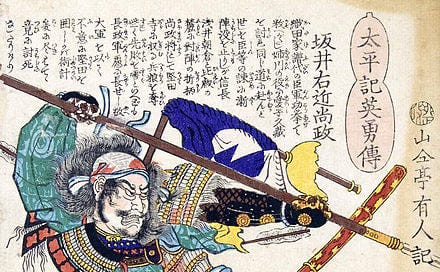Sakai Masahisa, (坂井 正尚) also known as Masashige, was a warrior mentioned numerous times in the famed Shincho Koki, the Chronicles of Oda Nobunaga, where he appears recorded as Sakai Udon, and recognised on his death as “A single man of great ability, whose fame is unparalleled,"
Sakai Masahisa’s early life is unknown, and while his actual date of birth is unknown, it is believed he was born in either present-day Gakuden Village of modern day Aichi Prefecture, although the old records, the Goyuden no Kami no Nikki mentions he was originally from Mino, Gifu Prefecture. As Sakai Masahisa was thought to have been a retainer of the Saito clan of Mino before entering the services of Oda Nobunaga on the destruction of the Saito, the Mino origins theory is currently favoured.
There were other retainers within Nobunaga’s ranks with the family name of Sakai, such as Sakai Daizennosuke, a chief retainer of the Kiyosu Oda clan, and Sakai Toshisada, a magistrate of the Oda clan, and it has been speculated that they may have been somehow related, but these relationships are unclear.
Sakai Masahisa’s name first appears in the Shincho Koki alongside that of the illustrious Shibata Katsuie, Mori Yoshinari, Hachiya Yoritaka and Hosokawa Fujitaka in the September 1568 entry when the Oda army stormed Iwanari Tomomichi’s Shoryu-ji Castle in Kyoto. At that time, Sakai's unit took more than 50 enemy heads.
Again he was mentioned for his prowess in the entry regarding the late August 1569 Invasion of Ise and the violent fighting in the attack on Okawachi Castle, where he was deployed with six other Oda generals, including Saito Toshiharu, Hachiya Yoritaka, Nakajo Ietada, and Isono Kazumasa, as a part of the main attack from the north.
In the spring of 1570, he participated in the attacks on Echizen, where Sakai’s exploits gained him even further mentions. Two months later, while Nobunaga attacked his brother-in-law, Azai Nagamasa, Sakai Masahisa, along with Mori Kanenari, Saito Toshiharu, Ichihashi Nagatoshi, Tsukamoto Kodaizen, Sato Hidekata, Fuwa Mitsuharu, and Maruke Nagateru, attacked Hibariyama at the foot of Odani Castle. As the castle began to fall, Sakai ordered his troops hasten the process by ordering the extensive castle town within the valley be burned down.
Sakai Masahisa was then honoured with a front-line position at the of Battle of Anegawa — a position awarded only to the strongest and bravest of loyal warriors — in which Sakai and his men acted as the Oda force’s spearhead, becoming the first to engage the enemy. However, in the thick of this battle, Sakai's troops were caught off guard and were routed. Sakai Masahisa watched as his eldest son, Hisatsune (also known as Kuzo), and nephew Jubei, were killed in action fighting against the Azai troops. After the battle, seeking revenge, he claimed that the Sakai unit as a whole were unable to perform as well as expected, and so Sakai Masahisa approached Nobunaga and requested that he be allowed to make up for the shortcoming by leading troops in the Battle of Shiga, a long campaign that turned into an extended siege of the militaristic monastery sect on holy Mount Hiei. As the long-term battle drew to an end, Ikai Nobutada of Katada Castle surrendered, and Sakai attempted to enter and capture Katada together with the troops of Ando Uemonnosuke and Kuwabara Heibei. As they neared the fallen fortress, Sakai and his troops were isolated in a sudden counterattack from the Asakura forces led by Maenami Kagemoto, who had been ensconced in the temples of Mount Hiei. Sakai fought bravely, killing the enemy warrior and commander Maenami Kagemoto in the skirmish, but was in turn killed in the heat of the Battle of Katada on December 23, 1570.
In the Shincho Koki, it is said that Sakai Masahisa was "A single man worth a thousand men, and his renown was unparalleled."
After Sakai Masahisa's death, his second son Etchu no Kami (actual given name unknown), succeeded him, but this son too was killed by Akechi Mitsuhide’s troops in the Honno-ji Incident, fighting alongside Oda Nobunaga’s son, Nobutada, while stationed at Nijo Castle, ending the Sakai family line.
Little information remains on this brave Sengoku warrior, but his name, his exploits, and his date of death,…. all which live on in the records of the Shincho Koki.




